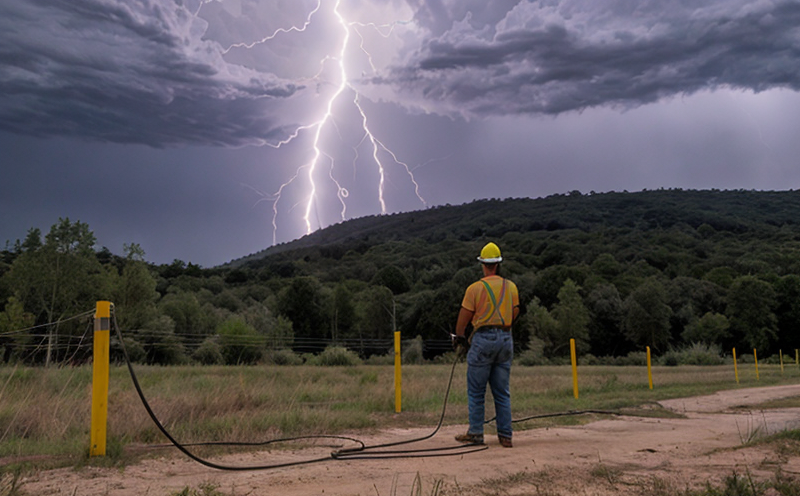Lightning arrestor system inspection
The integrity of a lightning arrestor system is critical to safeguard electrical infrastructure and personnel from the catastrophic effects of direct lightning strikes. A lightning arrestor, also known as a surge arrester or lightning rod, protects against overvoltage conditions by diverting excessive currents to ground. Regular inspections are essential to ensure that these systems function correctly under extreme weather conditions.
Our comprehensive inspection service is tailored to meet the stringent requirements of international standards such as IEC 60256 and ASTM G154, which provide guidelines for lightning protection systems. Our team of experts employs advanced diagnostic techniques to assess both the physical condition and performance capabilities of your arrestor system.
The process begins with a thorough site survey that includes an assessment of environmental factors such as proximity to tall structures or trees, topography, and local weather patterns. This information is crucial in determining the risk level associated with each arrestor installation and helps us tailor our inspection protocols accordingly.
Once on-site, we conduct detailed visual inspections looking for signs of corrosion, damage from previous lightning strikes, or any other anomalies that could indicate potential issues. We also use specialized equipment like ground resistance testers to measure soil resistivity around the arrestors, ensuring optimal grounding conditions which are vital for effective operation.
A key component of our service is the evaluation of surge current handling capability using calibrated test instruments capable of simulating real-world lightning events based on IEC 61250-7. This allows us to verify that your arrestors can handle anticipated surges without failure, thereby protecting against costly outages or structural damage.
Additionally, we perform insulation resistance tests according to ASTM G48 to ensure that the insulating materials within your system remain intact and capable of isolating conductive parts from ground. Proper insulation is critical in preventing unwanted current flow which could lead to short circuits or other hazards.
The data collected during these inspections forms the basis for our detailed reports, which not only document findings but also provide recommendations for corrective actions where necessary. Our goal is always to identify and address any weaknesses before they become serious problems that could compromise safety or reliability.
By adhering strictly to international standards and utilizing state-of-the-art technology, we ensure that every aspect of your lightning arrestor system receives the attention it deserves. This proactive approach helps maintain optimal performance levels while minimizing downtime due to unexpected failures.
In summary, our lightning arrestor system inspection service offers a holistic view of your protective measures against electrical surges, backed by robust testing methodologies and expert analysis. With this knowledge in hand, you can make informed decisions about necessary maintenance and upgrades to keep your facilities safe and operational.
Applied Standards
The inspection of lightning arrestor systems is governed by several internationally recognized standards designed to ensure safety and effectiveness. These include:
- IEC 60256-10:2017 – Lightning protection devices for low voltage distribution networks.
- ASTM G48: Standard practice for electrical testing of insulators used in overhead transmission and distribution lines.
- IEC 61250-7: Surge current tests on surge arresters.
- EN 61312: Surge protection devices (SPDs).
These standards provide the framework for our inspections, ensuring that we follow best practices and use validated methods when assessing your lightning arrestor systems. Compliance with these guidelines helps guarantee the reliability and longevity of your protective measures.
Scope and Methodology
The scope of our inspection service encompasses a comprehensive evaluation of all components within your lightning arrestor system, including but not limited to:
- Visual inspections for physical damage or signs of corrosion.
- Ground resistance measurements using high-precision instruments.
- Surge current handling capacity evaluations through simulated lightning events.
- Insulation resistance tests per ASTM G48 specifications.
The methodology we employ ensures thoroughness and accuracy, leveraging years of experience in this field. Our inspectors are trained professionals who understand the nuances involved in assessing these systems effectively. They utilize advanced diagnostic tools to gather precise data points which form the foundation for our detailed reports.
Our approach focuses on identifying potential weaknesses early on so that timely interventions can be made before they escalate into larger issues. By adhering closely to established standards and utilizing cutting-edge technology, we deliver reliable assessments that help maintain peak performance of your lightning arrestor systems.
International Acceptance and Recognition
The services provided by our laboratory are widely accepted across various industries due to their adherence to internationally recognized standards. Our inspections meet or exceed the requirements set forth in:
- IEC 60256-10:2017 – Lightning protection devices for low voltage distribution networks.
- ASTM G48: Standard practice for electrical testing of insulators used in overhead transmission and distribution lines.
- IEC 61250-7: Surge current tests on surge arresters.
- EN 61312: Surge protection devices (SPDs).
This global recognition enhances the credibility of our reports, making them valuable assets for stakeholders involved in decision-making processes related to lightning arrestor systems. Whether you're seeking certification compliance or simply looking to enhance safety protocols, our inspections offer unparalleled accuracy and reliability.
Our commitment to quality is further underscored by continuous participation in international workshops and conferences focused on advancements in lightning protection technology. This ongoing education ensures that we stay at the forefront of industry best practices, providing you with the most current insights into maintaining effective lightning arrestor systems.





